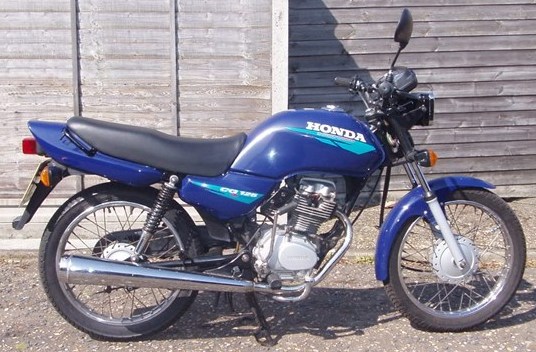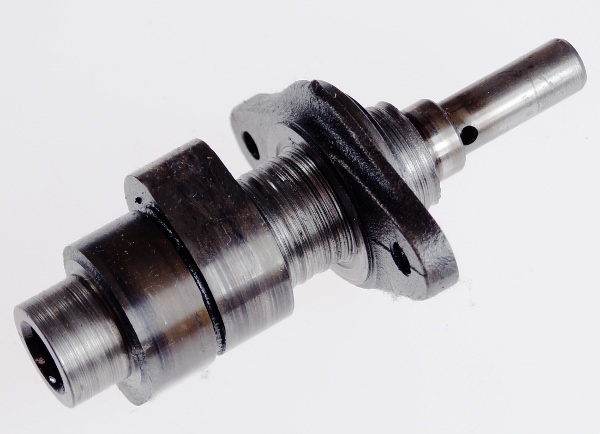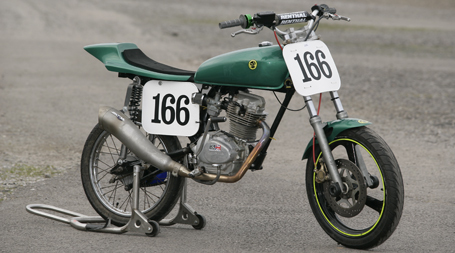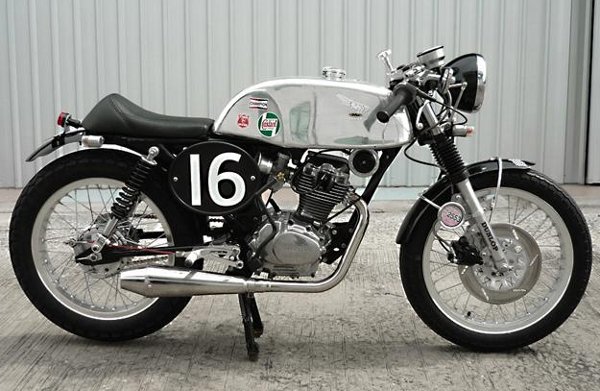Bike of the week- Honda CG125
Ah the old CG - it's on the whiteboard of awesomeness
Jerry Rulf
Ah, the old CG. Every single biker on earth has ridden one! Fame! They're gonna live forever! But they're not gonna learn how to fly, as they are too slow to ever take off..
I have owned a '76, a '95, a '98 and borrowed a 2005 for a bit, spannered all of them extensively, and I'm telling you they are magic, demon and ace, no arguments. I have also owned 2 CB125s OHC models and they do not compare well... more of that later.
For those of us who are comfortable with our own image, the CG is the perfect bike. It will not give you improved self esteem when approaching persons in whom you have a romantic interest.
If you think a big fast motorcycle makes others doe-eyed with desire, then you won't be thinking about having a CG as your main bike.
That said, all right-thinking people who know about motorcycles love them, and with good reason.
1. They are almost insanely reliable.
2. They don't have any inbuilt weak spots.
3. They don't need an expert to do any maintenance or rebuilding.
4. They can do 152mpg. I know, I did it.
5. Spares are crazily cheap and can be got anywhere on earth.
6. They sound nice.
A bit of historical context.
Honda. Cams in heads. Oh no! It's knackered!
Yes folks, in the early 70s pretty much all Hondas were designed with a ticking bomb in the cylinder head.. despite everyone knowing that cams running directly on the alloy head was an appalling engineering idea, Honda continued doing it for ages, because it was cheaper to make.
Unfortunately for owners, if you wanted your engine to last more than 30,000 miles, you had to change the oil every day after breakfast, which was inconvenient for some.
Luckily for us, there were emerging markets which were apparently full of lazy incompetents who needed a bike which wouldn't blow up- I refer you to Honda's own quotes-
“The Shocking State of Motorcycles in Developing Countries”
“Due to a lack of proper maintenance-a condition unique to that part of the world-Honda was losing ground to other manufacturers.”
“They spent a month watching motorcycle users in major cities throughout Thailand, Malaysia, Indonesia, the Philippines, Iran, and Pakistan. What they saw, though, was beyond anything they could have imagined.”
“the concept of routine maintenance was completely foreign to the dealers
and customers.”
“The examples of such abuse went on and on. One after another, we saw
spectacles we'd never even imagined possible from our home base in Japan.”
Hmm.. yes, well, let's just gloss over the fact that many of their OHC engines were flawed shall we? Instead, let's blame the customers!
Anyway, in 1974 they designed what would become the CG125- going back to using pushrods for the valves instead of the troublesome overhead camshaft.
This was combined with an enclosed final drive chain (already seen on cubs) and washable foam air filter. Valve clearances could be adjusted easily, three bolts and the rocker cover came off without even removing the tank.
Checking the simplicity of the design, Honda found that-
“Within a mere 20 minutes, they were able to reassemble the portion of the engine above the cylinder, including the new OHV mechanism. The engine started on their very first attempt!”
I've timed myself doing the same, and did it in 35 minutes, but it only started second kick. Try that on your VFR750.
As every schoolboy knows, the CG125 is the king of engines. Why then, did Honda never make a 250? or 350? It would have been awesome. I reckon they missed a trick there- instead we got stupid OHC engines with all the usual issues.
Both my early OHC CB125s' suffered top end wear, and although tiny beautiful and charming, I wish they had the CG engine instead.
Here, for example, is the camshaft of an XL250 that recently ate itself. They are still doing it.
Some things about the CG
- They do 60ish mph, 70 downhill.
- They are fast enough for town.
- First 1976 model had shrouded forks and different fork seals to all the rest.
- Started as 6v with points, ended up as 12v CDI with electric start.
- Early bikes had 17” rear wheel and skinnier rims and tyres.
- Later Brazilian built models had longer swingarm, longer wheelbase.
- From 1998 (W model built in Turkey) had different head gasket.
- Tyres last roughly one ice age.
It had a few minor design changes to most parts over the many years of production, and no, not all Chinese copy parts fit. In fact lots that I've tried don't, so be warned!
Predictably, the last models with disc brake and electric start are the best. Honda supposedly stopped making them due to emissions legislation, putting their eggs into the CBR125 basket.
That has left the Yamaha YBR125 to take over, and its big sales would indicate Honda dropped the ball when deleting this bike- why didn't they just bung on fuel injection? Or even the whole CBR lump?
A despatch rider-
“I used it for a good 3 years, 2 other people had it after. Went on forever. Mine caught fire out the carb, it was a great bike! The bike eventually fell to bits, my mate has got the engine under his stairs now, it still works!”
He rode every bike around in the 80s and 90s. He rates the CG as the best.
You know I said there's nothing wrong with them? Well, actually there is...
The swingarm has a reinforcing panel- this can get water in it if left in a hedge for 10 years, and can rust through. Not a problem most bikes will have..
Another issue is the stupid Honda thing of having the centrestand and brake pivoting around the same spindle, which runs in the frame. Given that many owners won't (don't) grease these, (no grease nipples either) you often get oval holes on the frame, seized centrestand on the spindle and seized or worn pivot on the brake pedal- and it's a tricky job getting an angle grinder in there to cut it all out... I have successfully cut open the centrestand, bent it apart to get the spindle out, then welded back up along the cut, but it's a lot of bother that could have been avoided at the design stage..
The big nut/cover on the crankcase which reveals the gauze oil filter is often overtightened, and can be a right pain to get undone without chewing it up. Speaking of which, having a gauze and centrifugal oil filter (again often overlooked and clogged as you need a Honda clutch tool to get it apart) means they depend on maintenance to be long lived- that's a big ask when most owners are young learners.
The problems that most often arise are from that curse - the former owner. As a CG is likely to have had a lot of these, chances are it has been bodged or damaged by well meaning but incompetent spannerers. If you can find one that hasn't been intimate with Dewhurst the master butcher, then that's a good sign.
I had one that ran fine but had a slightly weepy head gasket - I discovered the head was only pinched up on 3 studs, the other stripped in the case. But it still ran, and I homemade a stud with M10 on the bottom (standard is M8) and fixed it. That's the kind of bike we're talking about here, fixable.
Due to their simplicity, Cgs seem to be popular as the basis for specials, and why not?
Decent bikes are still popular, and ratty ones are still cheap enough to be a great learner and first bike.
So- on my “whiteboard of awesomeness” the CG remains top doggy. Who's a good boy then? You are! Yes you are!
Ah what a lovely and uplifting bike of the week indeed that was - thank you Jerry.
And who among you agrees with him? Is is it on your "whiteboard of awesomeness?"






